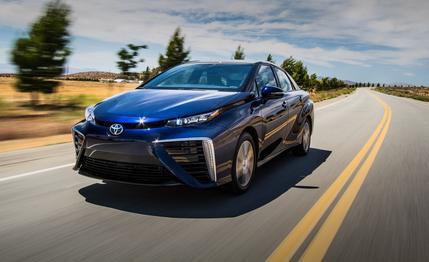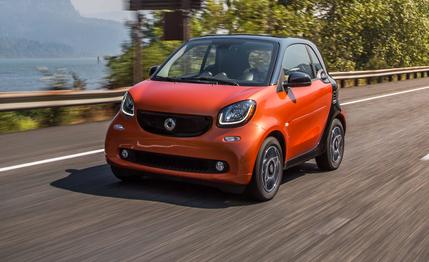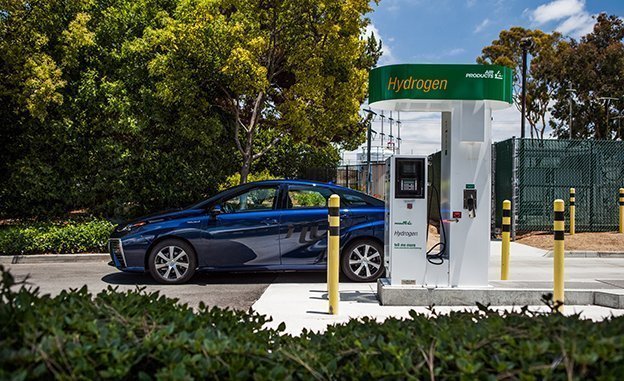
 Instrumented Test
From the September 2015 issue
Instrumented Test
From the September 2015 issue
Mirai is Japanese for “the future.” This is Toyota’s way of saying that its sedan most resembling SpongeBob SquarePants on a skateboard runs on hydrogen and produces no emissions. The Mirai is the first fuel-cell car offered for sale, not just lease. (The conceptually similar Honda FCX Clarity and Hyundai Tucson FCEV remain corporate property through and after the duration of their leases.) The standard rap on fuel-cell vehicles—that the technology is always five years away—expires when eight California dealers deliver 200 Mirais before the end of the year, followed by another 2800 cars over the next two years. The $58,325 base price isn’t much of a return on the 23 years of development and 5680 patents that Toyota invested in this future, but milestones never come cheap.
To test not only the Mirai but also the first phase of infrastructure that supports it, we visited hydrogen filling stations in the greater Los Angeles region and drove north to the Mojave Desert for performance measurements. Toyota engineer, future thinker, and fuel-cell authority Jackie Birdsall served as chaperone and tour guide without whining about our preemptive range anxiety, barrage of tech questions, or blind-curve photographic maneuvers.

 Top left: The Mirais cabin is less Camry, more Starship Enterprise. But its self-consciously futuristic; the capacitive-touch info displays are relatively conventional, just broken up onto three screens. Right: The filler needs a hard shove to mate with the Mirai.
Top left: The Mirais cabin is less Camry, more Starship Enterprise. But its self-consciously futuristic; the capacitive-touch info displays are relatively conventional, just broken up onto three screens. Right: The filler needs a hard shove to mate with the Mirai.
Versus the 10,000 or so gasoline stations in California, early adopters will have no more than 20 locations throughout the state to refuel their Mirais. We began our L.A. Basin infrastructure assessment by topping off the Mirai’s two hydrogen tanks at a Shell station conveniently located across the street from Toyota’s Torrance, California, headquarters. Hydrogen delivered at 10,000 psi gave us an indicated 270 miles of range. This station is fed by an Air Products pipeline that has served nearby oil refineries for 20 years.
Operating the filler nozzle takes patience and a firm grip; push in smartly, yank to verify a secure connection, then squeeze and latch the handle to meter. Birdsall’s coaching helped. To increase its density, the hydrogen gas is chilled to just above 0 degrees Fahrenheit. Though the nozzle drips with condensation, it’s not cold to the touch.
Before our side trip for testing, we topped off at a municipal services yard in Burbank, home to Disney, Warner Bros., and many classic TV shows. This pump was hidden, but once we located it and entered Birdsall’s secret free-fuel codes, our tanks were full in four minutes, resetting the range display to a healthy 270 miles.


The Mirai is at home in the L.A. sprawl. It’s comfortable, isolation-chamber quiet, and a pleasant means of enduring clotted freeways. Taking advantage of this car’s eligibility for the city’s high-occupancy-vehicle lanes, we cruised at the speed limit past the creeping CO₂ producers.
While the Mirai’s ability to reach 60 mph in 9.4 seconds and 80 mph in the quarter-mile is adequate to keep up with the Priuses and pool cleaners’ pickups, it’s unlikely to accelerate any enthusiast’s heart. When you nail the right pedal, there’s a gentle moan and the nose rises eagerly, providing a false sense of acceleration. But with only 152 horsepower propelling a Camry-sized car weighing more than two tons, this is no Tesla.
Other character traits are more satisfying: Michelin Primacy MXV4 215/35R-17 tires and a nicely tuned suspension deliver crisp steering response. Little of L.A.’s pavement ripple reaches the driver’s seat, and body roll is well damped. The Mirai stops from 70 mph in 194 feet, only three feet longer than the last Prius we tested.